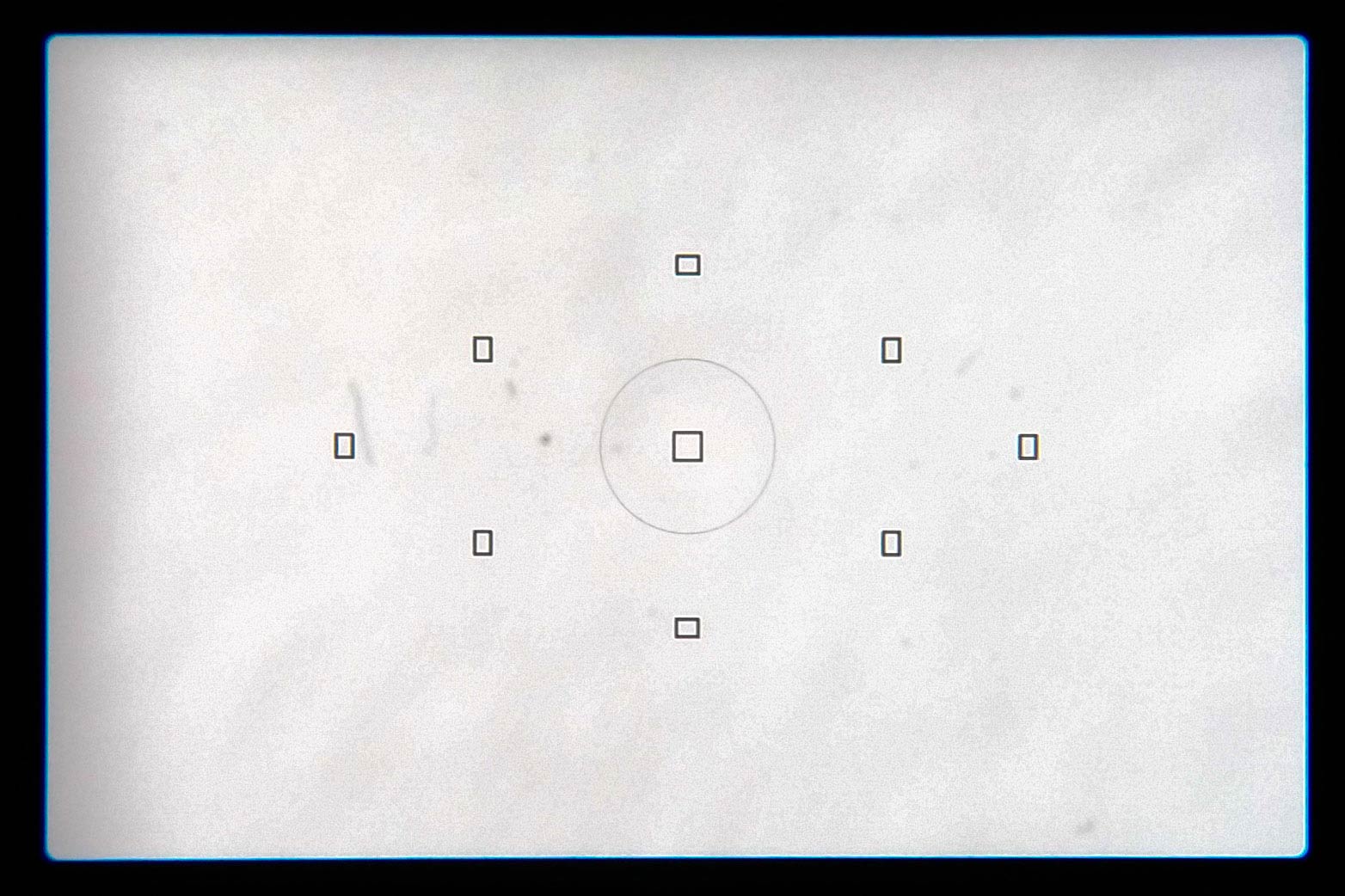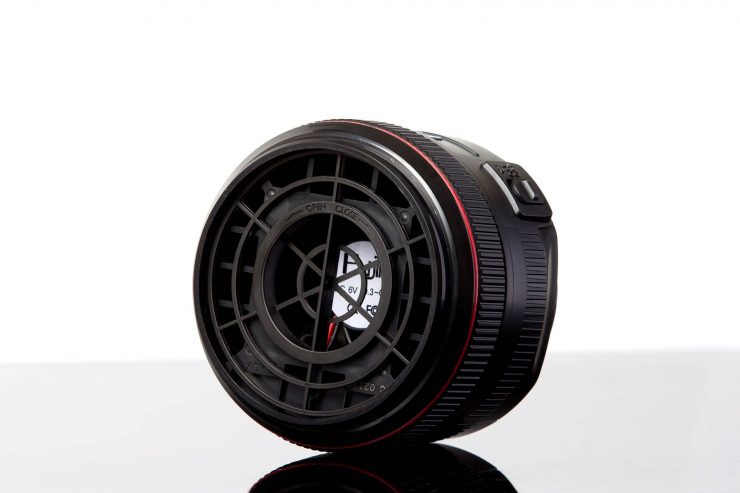The Fujin Mark II aims to solve an age old problem: dust inside the camera. Dust on a camera sensor can be an annoying problem for image quality, but personally, dust on my mirror and focusing screen really drive me crazy. The Fujin1 Fujin is the Japanese/Shinto god of the wind. Mark II has a unique strategy to deal with dust and lint particles in the sensor area and mirror box of SLRs: it is a essentially a lens-shaped vacuum cleaner that pulls air into the camera through a filter (keeping the air clean) and, after that air has swirled around the camera and hopefully picked up any debris that might be present, it is blown back out through the end of the “lens”.
It’s a great idea. Many popular tools for the same job raise more concerns than they solve: blowers like the popular “Rocket” may blow more dust into the camera, either in the initial puff of air from the nozzle or sucked in by the consequent eddies around the wide-open lens mount. Brushes and sensor cleaning swabs run the risk of scratching the sensor or damaging other delicate parts inside the camera… or at least, the risk seems real enough that many photographers avoid the task altogether and just live with the dust.
The Fujin, though, seems comparatively simple and risk free. It works on the same principal as a laminar flow hood used by technicians working in sterile environments; the constant flow of clean air in also stops a reverse flow of contaminated air, and it works without physical contact with any sensitive parts inside the camera. As such, photographers can feel comfortable attaching it to their cameras on a regular basis and keeping the problem under control.
But the Fujin Mark II isn’t cheap. It is currently listed on their website at $150, while many of the other tools listed above cost less than $20. Is it worth it?2 The wonderful people at Fujin sent me a free copy for evaluation, and although I always do my best to remain objective, I may not be immune to influence.

Functionality
Does it work? After a few days of testing, the simple answer is that it appears as though it should work, but I just don’t know whether it actually does. Let me explain.
The makers of the Fujin openly state the the unit should not be considered a primary cleaning tool for cameras with stains or old, stuck-on dust particles. Rather, it should be used as a maintenance tool for new cameras or those that have recently been professionally cleaned.
Unfortunately, all of my camera bodies are heavily used and have either (a) not been serviced recently, or (b) they’ve been serviced so recently that they have not accumulated any dust particles that could potentially be removed by the Fujin unit as it was intended to be used.
So, I decided to give it a try with a dirty old camera and see whether this off-label use would give me any results. I pulled my Canon 60D from the shelf and took a look through the viewfinder, and found what I expected: at sizable collection of lint filaments and dust particles on the focusing screen. I photographed them through the viewfinder, and marked the largest seven particles for future examination. They show up poorly in the image, but were quite clear in person. At least three of the pieces were long, fluffy-looking particles that I hoped would respond well the the air-flow.


But of course, the Fujin people had told me not to expect it to work for this sort of thing, so this doesn’t mean anything. It is, however, the only test that I could reasonably do, so I’m including it here anyway.
That said, it is quite clear that the unit functioned as expected. The air-flow created by the fan was considerable, even with the filter in place. I played around with it quite a bit; I tore a piece of paper into a pile of tiny bits and the Fujin sucked them through from 4 inches away, without even being in an enclosed space. I tried the same thing with a pile of table salt and had spectacularly messy results, and was reminded that safety goggles are a good idea for this type of product testing work.
So, I’m giving this a “7” for functionality, despite not being able to give it a practical test. I’ll keep testing it on my Canon 5D Mark III over the next few months and update this review as I learn more.
Design
When it comes to the product design, I don’t have many complaints. The body of the unit is pretty cool: it looks a lot like a Canon 50mm f/1.2L lens, complete with the red “L” ring, and the packaging is attractive, with a high-end feel. There’s a red LED power indicator light, which is handy, and the storage pouch is a nice touch, too. The power switch is easy to operate.
My only major complaint is that the unit is powered by four AAA batteries rather than drawing power from the lens-mount. This means that I have to buy extra batteries (I never use AAAs, so I don’t have rechargeables), and it also adds to the weight of the product if I want to carry it while traveling. The 6 volts provided by the AAAs could just as easily be pulled from the 7.2 volt Canon LP-E6N battery; the mount is able to power the large autofocus motors in 600mm f/4 lenses along with their image stabilization systems, so it should certainly be able to handle a fan motor.

The only drawback to being powered by the camera itself, as far as I can tell, would be that the unit could not be powered-on while detached from the camera, and the Fujin team does recommend running the fan for a minute before attaching it to the camera in order to clear out any dust. This seems like a trivial concern, especially if the product works as well as intended, and it could be mitigated further with dust-proof caps. Ideally, the unit would contain a small rechargeable battery that could be charged via USB (either instead of or in addition to the lens-mount power).
Speaking of batteries, I was pleasantly surprised at how easy it was to remove the batteries after I got them into the battery compartment; this can be a struggle with some pieces of equipment that are designed for a compact build, so this was a nice change.
Build Quality
There are a couple of factors that need to be considered when evaluating something as subjective as build quality: function and price. Is the product going to hold up to prolonged use, when used as intended? And more subjectively, does the product feel as expensive as it was?
In terms of function, the Fujin Mark II gets full marks. The plastic housing doesn’t seem bullet-proof, but it’s certainly strong enough to sit on a shelf and occasionally be attached to the camera and switched on and off. It’s not designed for rugged use in the field like a real lens, so I don’t hold it to that standard. It seems perfectly solid. It’s also certainly rugged enough for knocking around in a camera bag while traveling.
On the other hand, it doesn’t exactly feel like a $150 piece of equipment. It does have a rubber mock focus-ring, which helps. However, the lens mount is entirely plastic rather than metal, with no rubber gasket to improve the seal between the housing and the camera. When I connect a real lens to my camera, whether its mount is metal or plastic, I expect it to snap into place with a satisfying “click”, and while the Fujin does click, it doesn’t feel like a tight fit.
You might say, “But giving a metal lens mount would be prohibilitvely expensive, and it doesn’t need one anyway!”
As for the expense, let me direct your attention to the macro extension tubes that I bought last year. The set of three contains six metal lens mounts (two on each ring), which produce a very solid connection between the camera and rings, and I don’t worry that they’ll continue to loosen up over time (though they are not the sturdy stainless steel that you’d find on an “L” lens, for example). The set cost me about $25, and it includes electronics to support autofocus; cheaper options were available for less than $9.
Granted, they were probably made by Chinese child-slaves, and I’d prefer not to support such things, though it’s hard to avoid these days. Still, even at double or triple the price, the extra cost of a metal mount would be insignificant compared to the $150 price tag of the Fujin.
I give it a 7 overall.
Value
I’d like to be able to say that it’s optimistic to expect that Americans will buy the Fujin Mark II for $150, but to be honest, it’s worse than that… it’s bordering on silly. If it cost $50, it might find a good market, but at $150, I’m having trouble imagining the buyer.
Let me start, though, with the product itself. It’s a few pieces of molded plastic 4 I haven’t taken it apart, but I’d guess it contains somewhere in the range of 6-10 pieces of plastic, including the front and rear grills and the battery cover. , with a switch, an LED, some basic electronics, a small fan inside, and a bit of filter cloth. For contrast, the Canon 50mm f/1.8 STM lens also has a plastic body and a switch, but additionally has a metal lens mount, some impressive electronics, a stepping auto-focus motor, an aperture mechanism, a variety of moving parts to focus the lens, and 6 precision glass elements, and with all of that, the lens costs $25 less than the Fujin Mark II. Why is the Fujin Mark II so expensive?
In New York, it costs about $40-$50 to get your sensor professionally cleaned; here in Seattle, from $50-75. How many amateur photographers would opt to spend 2 to 3 times that amount to buy a piece of equipment that may (or may not) help keep their sensor clean longer, but will not reliably clean it if it’s been dirty for a while? This is especially problematic if that photographer has also just paid to have the sensor cleaned. For those purchasing new cameras, also buying a Fujin would require giving the average American considerably more foresight than I’d normally credit them.
While many of us are perfectly happy to spend more money for genuine Japanese goods when those goods require fine precision or craftsmanship, I fear that at this price point, this is the type of product for which most people will say “I’ll wait for the $20 Chinese knock-off; it should work just as well”. Whether it’s worth $150 or not, few Americans will pay for it.
That said, history has shown that there are plenty of people who will pay good money for just about anything, especially when it comes to camera gear. I hope, for the sake of the charming people I’ve spoken with at Ipp USA, that I am wrong.
Verdict
It is a great idea, and the Fujin will probably work as intended, although its intended use is probably somewhat less ambitious that many potential buyers would hope. I’d happily use one on a regular basis, especially during those times when I’m working in a sandy or dusty environment, but I’m disappointed at the high cost and I’d have to really have a serious problem with dust to decide to pay it.










